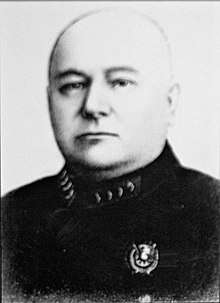Jukums Vācietis
Jukums Vācietis (Russian: Иоаким Иоакимович Вацетис, Ioakim Ioakimovich Vatsetis; 11 November 1873 – 28 July 1938) was a Latvian Soviet military commander. He was a rare example of a notable Soviet leader who was not a member of the Communist Party (or of any other political party), until his own demise during Joseph Stalin's Great Terror.
Jukums Vācietis | |
|---|---|
 Jukums Vācietis | |
| Born | 11 November 1873 near Saldus, Courland Governorate, Russian Empire (now Saldus municipality, Latvia) |
| Died | 28 July 1938 (aged 64) Moscow, Russian SFSR, Soviet Union |
| Buried | |
| Allegiance | |
| Service/ | Imperial Russian Army Red Army |
| Years of service | 1891–1938 |
| Rank | Polkovnik (Russia) Komandarm 2nd rank (Soviet) |
| Battles/wars | First World War Latvian War of Independence Russian Civil War |

Early life
Jukums Vācietis began his academic life at the Skede Parish School and the Ministry of Kuldiga school. He had a tough childhood. Besides studying, he also worked in a match factory.[1]
Military career
Vācietis started his military career in Imperial Russia in 1891. During World War I, he commanded the 5th Latvian Zemgale Rifle Regiment (eventually with the rank of colonel), which supported Lenin's Bolsheviks after the October Revolution and the ensuing Russian Civil War. From April 1918, Vācietis was the commander of the Red Latvian Riflemen division. From July to September 1918, Vācietis commanded the Eastern Front. Vācietis was the first commander-in-chief of the Red Army (RKKA), a member of the Revolutionary Military Council (2 September 1918 – 3 July 1919), forming a productive working relationship with Leon Trotsky, the Commissar for Military and Naval Affairs. On 3 July 1919, Sergey Kamenev replaced Vācietis as commander-in-chief of the Red Army, following certain discontent amongst some Bolsheviks over Red Army leadership in the Russian Civil War. On 8 July 1919, Vācietis was arrested under the accusation of membership in a counter-revolutionary reactionary White Guardist organization, but was soon released when the charge was proved false.
In 1922, Vācietis became a professor of the RKKA Military Academy (future Frunze Military Academy). During this time, he wrote several books, most notable among them being 'Latvian Riflemen's Historical Importance'. In 1935, Vācietis was assigned a personal rank of Comandarm, 2nd Rank.
On 29 November 1937, during the height of Stalin's Great Purge, Vācietis was arrested as a member of the alleged "Latvian Fascist Organization within the RKKA", and was executed on 28 July 1938. Vācietis was rehabilitated in 1957.

Literature
- Ģērmanis, Uldis (1974). Oberst Vacietis und die lettischen Schützen im Weltkrieg und in der Oktoberrevolution. Acta Universitatis Stockholmiensis; Stockholm studies in history (in German). 20. Stockholm: Almqvist & Wiksell. OCLC 1171718.
- Jēkabsons, Ēriks (2005-04-01). "Krieviski. Ar jūtamu akcentu (Nezināmais Vācietis)" (PDF). Mājas Viesis (in Latvian). Latvijas Avīze. pp. 10–11. Archived from the original (PDF) on 2005-12-14. Retrieved 2008-06-13.
- Ģērmanis, Uldis (1969–1972). "Zemgaliešu komandieris". Jaunā Gaita (in Latvian). 76-90. Cite journal requires
|journal=(help)
References
- "Jukums Vācietis". Nekropole.info. Retrieved 31 January 2013.
| Wikimedia Commons has media related to Jukums Vācietis. |